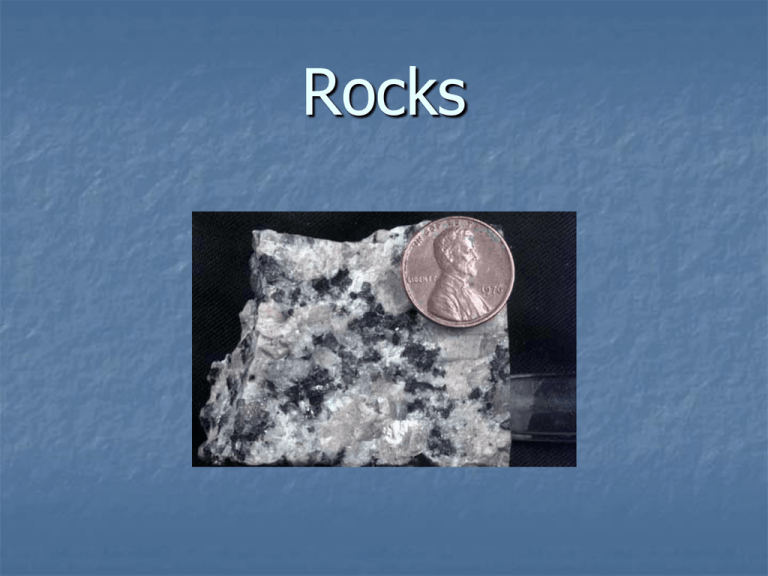Intrusive Rocks
advertisement

Rocks Rocks Mixture of two or more different minerals that have been: cemented together squeezed and heated together melted and cooled together The Rock Cycle The diagram of the rock cycle shows how rocks change slowly over time. Types of Rocks 1. Igneous 2. Metamorphic 3. Sedimentary 1. Igneous Rocks “Igneous” comes from Latin for “fire” Most igneous rocks are produced deep underground by the cooling and hardening of magma (melted rock). Formation of Igneous Rocks A. Intrusive Rocks- form from magma that cools below the surface of the earth. Ex. Granite B. Extrusive Rocks- form as lava cools on the surface of the earth. Ex. Obsidian Examples: Formation of Igneous Rock -Extrusive- Formed from lava; volcanic Obsidian Pumice Intrusive- Formed deep within the earth Granite Textures of Igneous Rock 1. Glassy 2. Coarse-grained Obsidian Granite 3. Fine-grained Basalt 2. Metamorphic Rocks Formed from heat and pressure changing the original or parent rock into a completely new rock. The parent rock can be either sedimentary, igneous, or even another metamorphic rock. Classifying Metamorphic Rocks 1. Foliated- when mineral grains flatten and line up in parallel layers. 2. Unfoliated-when mineral grains grow and rearrange but do not form layers. Foliated Gneiss Unfoliated Marble 3. Sedimentary Rocks Form when sediments are pressed and cemented together, or when minerals form from solutions. Usually consist of layers Classification of Sedimentary Rocks 1. Detrital Sed. Rocks- (Clastic Rocks)Made of the broken fragments of other rocks. A. Weathering- the process of breaking rocks into smaller pieces. Happens when rock is exposed to air, water, or ice. B. Erosion- the movement of weathered material. C. Compaction- when the sediments stick together and form solid rock. D. Cementation- when large sediments are held together by natural cements that are produced when water soaks through rock and soil. E. Shape & Size1. Conglomerate- when the sediments are rounded 2. Breccia- when the sediments have sharp angles. Clastic Rocks Conglomerate 1. Sandstone 2. Mudstone 2. Chemical Sed. Rocks- Formed when dissolved material comes out of solution by inorganic processes such as evaporation. Examples are 1. Limestone and 2. Rock Salt 3. Organic Sedimentary RocksRocks made from the remains of once-living things Coquina Organic Sed. Rock Examples Fact about the Mississippi River Did You Know? The Mississippi River carries an average of 436,000 tons of sediment each day It moves an average of 159,000,000 tons of sediment a year Distribution of Rocks in the U.S.








